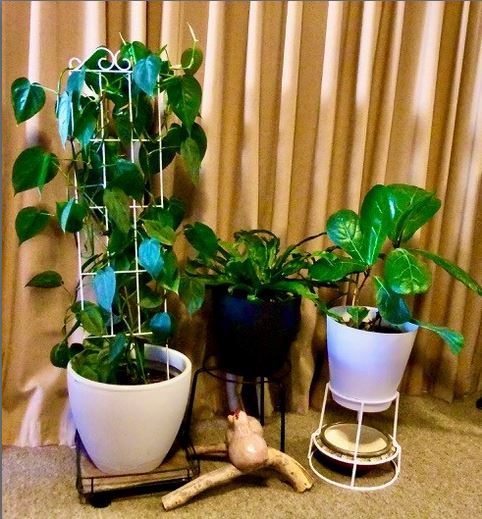May 17th, 2023Glen, about the house…

Indoor plants in winter
Many gardeners who have started a collection of indoor plants – like the
philodendron scandens, birds nest fern asplenium nidus and fiddle leaf ficus lyrata
– pictured above – and done well with them through summer, could be disappointed when
they suffer quite badly once the chills of winter are upon us.
Here’s why, and a few hints on how to avoid the worst of it.
Most of the plants we grow indoors originate from tropical and sub-tropical regions where winter temperatures are moderate and humidity relatively low.
Unfortunately this doesn’t apply to the greater part of Australia where
temperatures are generally rather low and the atmosphere is damp to dripping wet.
Added to this, the plants have invariably come straight from the warmth of an
often heated glasshouse, or in the case of the large chain stores, direct from NSW
or Queensland in a van, and will need some help to acclimatise. But more on that
another time.
It is under these conditions that indoor plants suffer most, usually from over-
watering and lack of light.
During the summer months the moisture content of pot soil will drop within a
few hours of watering, even in poorly drained soil, so the plant is unlikely to suffer
from wet feet.
In winter however, water stays in the soil much longer, leaving the plant open
to infection by root rot and other diseases brought about by micro-organisms.
Symptoms of over-watering are a general yellowing of the plant and drooping, and
the eventual dropping, of old leaves.
There is only one correct way to water plants during winter – or indeed
throughout the year – and that is to give them a good soaking drink when, and only
when, they are dry. Allow the water to soak right down through the soil and when the
soil is completely dry, soak it again.
When potted plants are watered lightly and frequently it is almost impossible to
assess their needs. Although the top soil is kept damp, the lower part where roots are,
could be either always dry or always wet. Both conditions are equally deadly for plant
life.
Other possible causes of leaf drop, especially at this time of year, are a sudden fall
in room temperature or fumes from gas fires.
Wherever possible, always place your plants in the best lit position away from
draughts.
Don’t feed them now, until the arrival of warmer weather because their need for
sustenance decreases until the arrival of spring. Unused fertiliser will only build up in
the soil and can cause root damage.
One of the few exceptions to this rule is the cyclamen, most of which would be
commencing growth and will need feeding as their flower buds form. Avoid repotting
until spring. They will take hold of the new soil much better when the new root
growths are developing.
A good spot to place indoor plants which appear to be suffering in some way
is in your bathroom. Here the steam from showers etc, raises the temperature and
humidity to a degree closer to that encountered in their natural habitat.
Keep their foliage clean and dust free by washing them with rain water or placing
them under the shower using the cold tap and a light pressure.
Keep a close watch for mealy bug or scale and treat them at the very first sign
because a very severe infestation can build up rapidly when plants are growing in a
warm, dry environment.
Got a gardening query? Email glenzgarden@gmail.com










